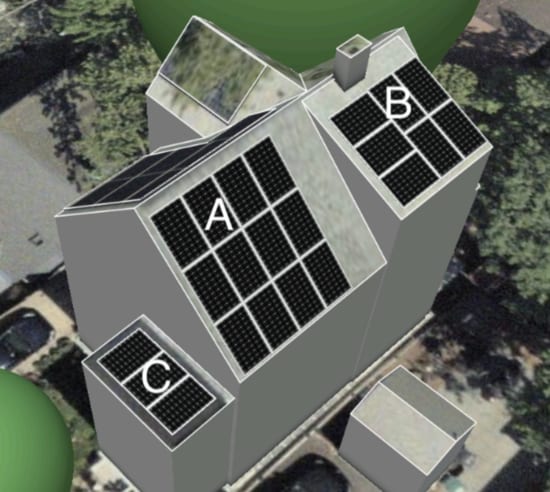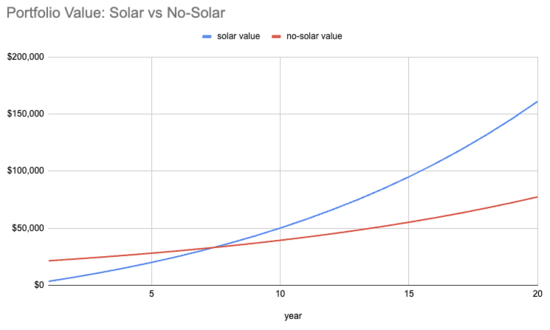In 2018,
we
installed 14 solar panels on the Northwest roof of our house.
This is a little silly: wouldn't you want to install them facing the
sun? The problem was the enormous tree to our Southeast, twice the
height of our house, completely shading that area. It was a great
tree, but it was causing problems for our neighbor, so they took it
down a couple years ago. I looked at getting solar at the time and
got as far as signing a contract, but then it fell apart a week before
install when the company said they couldn't actually install the
sunlight
backup system we had planned.
Since then, electricity has gotten more expensive while panels have
gotten more efficient and cheaper, and I started thinking more after
seeing how heat
pumps don't work out with our electricity rates. Here's what
we're considering:

This is 22 QCell
425W panels initially producing 9,292 kWh/year. That would give
about ~$3.2k/y in electricity savings + credits. I got quotes from
three companies, and the best (after tax credits) was around $20k.
This is pretty good ROI, with payback in 5-6 years. But what I really
care about is how this compares to what else I would do with the
money. This isn't money we need short term, so I think the
opportunity cost is whatever the stock market would do with $20k. But
these are very different sorts of things: with stocks you put money in
and at some point in the future you take an, ideally larger, quantity
out. With solar you put money in and then each year for the
life of the system you pay less in electricity. I don't know the right
way to compare them in an open-ended way, but we can analyze the
decision over a specific number of years.
I'm going to model two scenarios. In the first we take $20k from
stocks to put in solar, and then invest returns back into stocks. In
the second, we leave the $20k in stocks. Results here also depend on
what happens to stocks and electricity rates. I'm going to keep
everything in 2024 dollars, and guess a real (inflation-adjusted)
price increases of 7% for stocks and 3% for electricity [1]. It got a
bit too complex for a spreadsheet, so I wrote a script [2]. It
looks like it takes a bit over seven years before solar comes out
ahead:

I'm pretty sure this is the right way to do the analysis, but it's not
obvious: the version solar installers give you ignores opportunity
cost, and my first attempt missed that you invest your electricity
savings in stocks.
EDIT: It's actually slightly better for solar than this analysis
suggests because stock gains are taxed at a long-term capital gains
rate when you sell, while electricity you refrain from buying is
untaxed. Unfortunately, this is hard to work into the model because
I've done everything in real space but capital gains are assessed in
nominal space.
Overall, this seems pretty worth it, but I'm open to being convinced
it isn't!
[1] In 2018 we were paying $0.217/kWh ($0.265/kWh in 2024 dollars) for
electric, and now pay $0.316/kWh. This is 3%/y on top of inflation.
[2] In python:
STOCK_GROWTH_REAL=0.07
ELECTRIC_GROWTH_REAL=0.03
PRODUCTION_DECAY=0.9966
INCENTIVE_DECAY=0.945
INIT_PRODUCTION_kWh=9_292
INIT_ELECTRIC_RATE=0.32
INIT_INCENTIVE_RATE=0.033
SOLAR_COST=20_000
YEARS=20
solar_stocks = 0
non_solar_stocks = SOLAR_COST
production = INIT_PRODUCTION_kWh
electric_rate = INIT_ELECTRIC_RATE
incentive_rate = INIT_INCENTIVE_RATE
print("year", "solar value", "no-solar value", sep="\t")
for year in range(YEARS):
production *= PRODUCTION_DECAY
electric_rate *= 1 + ELECTRIC_GROWTH_REAL
incentive_rate *= INCENTIVE_DECAY
solar_stocks *= (1 + STOCK_GROWTH_REAL)
non_solar_stocks *= (1 + STOCK_GROWTH_REAL)
solar_stocks += production * (electric_rate + incentive_rate)
print(year+1, solar_stocks, non_solar_stocks, sep="\t")
Comment via: facebook, mastodon

